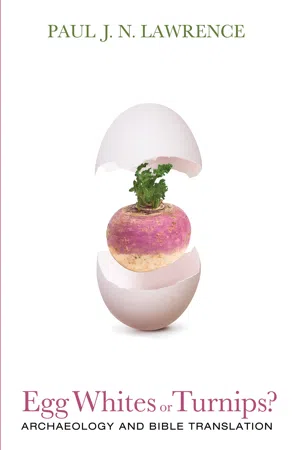
- 178 pages
- English
- ePUB (mobile friendly)
- Available on iOS & Android
About This Book
Why are Bible translations so different from each other in places? Don't Bible translators know whether it was peacocks or baboons that King Solomon brought into Israel? Why has "sapphire" been replaced by "lapis lazuli" in some more modern versions? What animal provided the leather for the tabernacle? A badger? A sea cow? Or did the term in question simply mean "leather"? Can archaeology tell us what David's harp looked like? What is the evidence for leprosy in Bible times? Is there evidence for cotton, silk, and chickens at the time of the Bible?Answers to these and many other questions are given in this book.But how are such questions to be answered? Essentially the answer is "from the ground"--what can be called "archaeology." This book explores how, over the past two centuries, archaeology has shed its light on the text of the Bible.
Frequently asked questions
Information
Archaeology and Bible Translation
Table of contents
- Title page
- Acknowledgments
- Abbreviations
- Chapter 1: Archaeology and Bible Translation
- chapter 2: “Is There Any Flavor in the White of an Egg?”Job 6:6
- Chapter 3: “He [King Uzziah] Made Machines . . . to Shoot Arrows and Hurl Large Stones” 2 Chr 26:15
- Chapter 4: “Praise Him with the Tambourine and Harp”Ps 149:3
- Chapter 5: “He [King Solomon] Described Plant Life, from the Cedar of Lebanon to the Hyssop That Grows Out of Walls”1 Kgs 4:33a
- Chapter 6: “He [King Solomon] Also Taught about Animals and Birds”1 Kgs 4:33b
- Chapter 7: “They Will Sparkle in His Land like Jewels in a Crown”Zech 9:16b
- Chapter 8: “Unclean! Unclean!”Lev 13:45b
- Chapter 9: “A Lion Shouted”Isa 21:8
- Chapter 10: “Woe to Me That I Dwell in Meshek”Ps 120:5
- Chapter 11: “Faith Is the Title Deed of Things Hoped For”Heb 11:1
- Chapter 12: Conclusion
- Appendix 1: Musical Instruments
- Appendix 2: Plants and Trees
- Appendix 3: Animals and Birds
- Appendix 4: Precious Stones in Exod 28
- Bibliography